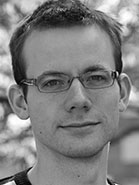|
 Michael Zugenmaier Michael Zugenmaier
A thesis for the degree of Doctor of Philosophy defended June, 2018.
The PhD School of Science, Faculty of Science, Quantum Optics, Niels Bohr Institute, University of Copenhagen
Supervisor:
Prof. Eugene S. Polzik
|
Towards a room temperature single photon source based on atomic vapour
Quantum communication allows for provably secure communication. The transmission probability decreases exponentially with the fiber length and therefore limits the maximum communication distance via direct fiber transmission. Classical information can simply be amplified to counteract the transmission losses. For efficient long distance quantum communication, quantum repeaters have to be used along the communication line. In a seminal paper by Duan, Lukin, Cirac and Zoller, the so-called DLCZ-protocol was proposed, utilizing atomic ensembles and their collective excitations for quantum repeaters. Mass deployment of quantum repeaters requires a scalable system and thus favors room-temperature platforms. However, until now atomic motion has impeded long lifetimes of collective excitations in room-temperature systems.
We demonstrate efficient heralding and readout of collective excitations created in warm caesium vapour. The caesium atoms are encapsulated in a glass cell with anti-relaxation coated walls. This paraffin coating ensures that the caesium atoms can collide many times with the wall without changing their atomic state. By using the concept of motional averaging, that is allowing the atoms to cross the excitation beam many times during the interaction, we can selectively address a long-lived collective excitation upon the detection of a scattered heralding photon. We have achieved a lifetime of a single collective excitation of 0.27 ms, two orders of magnitude longer than previous warm vapour experiments on the single photon level and we have verified non-classical correlations between the heralding field and the read out field. Currently excess noise contaminate the output of our source, preventing single photon output. We have identified the main noise contributions and demonstrated in a proof-of-principle experiment the suppression of excess scattering due to four-wave mixing. Reduction of the noise in the readout will allow us to use our device as an on-demand single photon source, advancing on the way towards quantum repeaters with room temperature vapour cells.
|